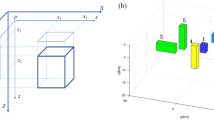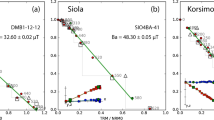Abstract
Recent theoretical interest in the possibility of observing a non-newtonian component of gravity arises from the lead that such observations will give to unification theories1. Absolute determinations of the newtonian constant G by geophysical methods, at mass separations several orders of magnitude greater than those available in the laboratory, provide information not obtainable in any other way. Stacey2 drew attention to the fact that modern geophysical measurements were precise enough in principle to provide an important check on G and Stacey et al.3 revived the mine method first used by G. B. Airy. Subsequently Stacey analysed a set of overlapping sea-floor and sea-surface gravity survey data made available by the Exxon Oil Co., to avoid the problem of density uncertainty that beset the mine measurements, and Stacey and Tuck4 compared the results with values of G calculated from published mine and borehole data. The striking conclusion was that the values of G were all systematically high. Residual doubts, especially concerning the adequacy of density sampling and the possibility of bias by regional gravity anomalies, left the conclusion as a rather tentative one. We report here a new determination of G, which is also high, but in which the doubt about density is substantially reduced. This information makes it implausible to explain the high value of G in terms of an inadequate knowledge of density. The possible effect of regional gravity anomalies is not as securely discounted.
This is a preview of subscription content, access via your institution
Access options
Subscribe to this journal
Receive 51 print issues and online access
$199.00 per year
only $3.90 per issue
Buy this article
- Purchase on Springer Link
- Instant access to full article PDF
Prices may be subject to local taxes which are calculated during checkout
Similar content being viewed by others
References
Gibbons, G. W. & Whiting, B. F. Nature 291, 636–638 (1981).
Stacey, F. D. Geophys. Res. Lett. 5, 377–378 (1978).
Stacey, F. D., Tuck, G. J., Holding, S. C., Maher, A. R. & Morris, D. Phys. Res. D23, 1683–1692 (1981).
Stacey, F. D. & Tuck, G. J. Nature 292, 230–232 (1981).
Dahlen, F. A. Phys. Rev. D25, 1735–1736 (1982).
Gravity Map of Australia, 1:10,000,000 (Bureau of Mineral Resources, Canberra, Australia, 1979).
Holding, S. C. thesis, University of Queensland (1984).
Author information
Authors and Affiliations
Rights and permissions
About this article
Cite this article
Holding, S., Tuck, G. A new mine determination of the newtonian gravitational constant. Nature 307, 714–716 (1984). https://doi.org/10.1038/307714a0
Received:
Accepted:
Issue Date:
DOI: https://doi.org/10.1038/307714a0
This article is cited by
-
Six years of the fifth force
Nature (1992)
-
Intermediate-range forces?
International Journal of Theoretical Physics (1990)
-
Actio-reactio symmetry breaking model fitted to the new tower-mine gravity experiments
Ingenieur-Archiv (1990)
-
An analysis of geophysical experiments to test Newton's law of gravity
Nature (1989)
-
Actio-reactio equations with finite wave speed derived from the principle of inertia
Acta Mechanica (1989)
Comments
By submitting a comment you agree to abide by our Terms and Community Guidelines. If you find something abusive or that does not comply with our terms or guidelines please flag it as inappropriate.



